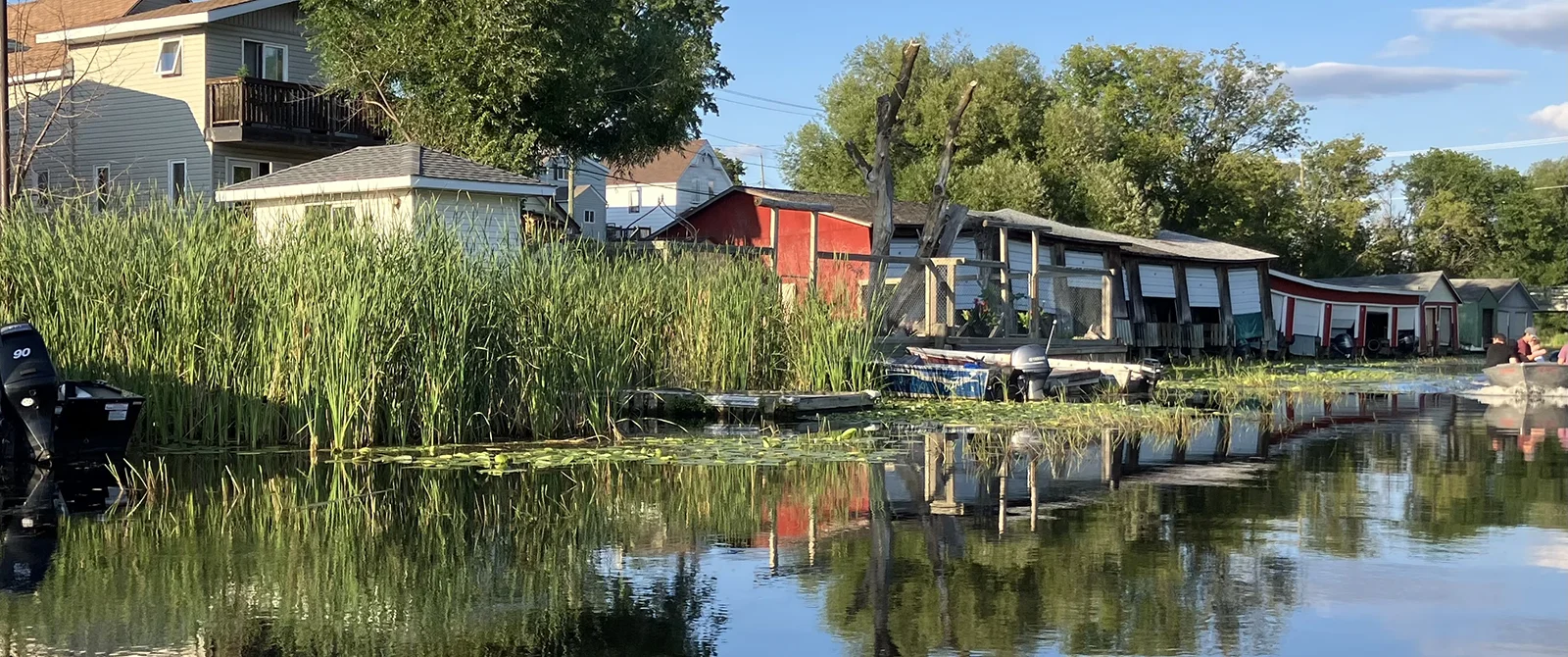Originally published in Lake of the Woods Area News, Volume 55, Number 3, Summer 2025
For those looking for a completely different boating experience, may I offer up Laurensons Creek in Kenora. While I suspect the best way to explore Laurensons Creek is with a paddle… in a kayak, paddleboard or canoe, it is possible to find yourself up the creek without a paddle. A small to medium-sized motorboat can navigate the narrow waterway, respecting its no-wake zone until it opens up into Laurensons Lake.
The creek begins its east-north-east course at the entrance flanked by the Safeway store and the Moncrief Construction Sports Centre (recreation centre). Under the bridge you go, at a snail’s pace, mind you, because right on the other side of the bridge are two busy enterprises—docking for the grocery store (the only Safeway store in North America that can be accessed by water) and a public boat launch on the opposite side.
The entrance to the creek has a storied history. Beginning in 1890 and lasting for decades, the site now occupied by the recreation centre was the location of a large sawmill operation which underwent various ownership and name changes throughout its existence—the Western Lumber Co., the Rat Portage Lumber Co., and the Keewatin Lumber Co. A box factory was also located on the site. On the opposite side of the creek was a sash and door factory. Both establishments ceased operations and burned down in the 1930s.
Safeway moved to the north-side site in 1956. Their customer docks, originally built with cedar posts and rock cribbing, were part of the initial design and were upgraded in the mid 1960s. At about that time the Town of Kenora acquired the land on the south side for the construction of a “community centre”. The Kenora Recreation Centre opened its doors in March 1968. It was branded the Moncrief Construction Sports Centre a few years ago.
As one travels east along the creek, houses and boathouses begin to line the shoreline, initially along the north shore. On the south shore, a wooden wall, anchored into the creek bottom, was constructed in the 1930s. Anecdotally it was a make-work project during The Depression, presumably devised to keep back the encroaching reeds that characterize much of the creek.
Eventually you come to the second bridge (Seventh Avenue South). In 2018, the bridge was reconstructed, replacing the one built in 1934 which replaced the original bridge. One can still see the dry stonework that provides the foundation of the structure. Once past the bridge, there is more housing on both sides of the creek. Small docks jut out from the reedy shoreline and in many ways, the scenery along the creek makes you feel as if you have entered another time and place. It is quiet and peaceful. There are no fast-travelling watercraft, no swimmers, and few people sitting on their docks. Backyards are on view. In some yards, gardens cascade down the north shore and you think, “I had no idea this is what backs the houses along Second Street.”
The final bridge is at Eighth Avenue South, where boaters pass under the busy Trans-Canada Highway. Beyond this bridge it is largely the north shore that is populated by residential neighbourhoods. The massive reed beds along the south shore make for some interesting navigation to businesses like K Sports and The Hardwear Company, but paths through the reeds have been cleared.
The passage is narrow as one moves towards the dogleg turn that brings you into Laurensons Lake. As you come into the open water of the lake, if you look to your right, you’ll see the Kenora Jail. This was the site of the first Lake of the Woods Brewing Company, which was established by Abraham Kingdon in 1898. Their brand name brews were named after gold mines on the lake—Sultana Lager, Mikado Pale Ale and Regina Porter. Their beer, “a healthful and invigorating drink for hot weather” (as one of their ads stated) was reportedly “made with the finest soft water from Laurenson Lake.”
It is generally accepted that the name of the creek and lake came from Robert Laurenson, initially an employee with the Hudson’s Bay Company (1864–1869), then the postmaster for Rat Portage (1874–1877), and then later an independent trader. Yet an undated sketch of the HBC Reserve in Rat Portage includes the names “Laurence Creek” and “Laurence Bay”. An earlier map of the reserve identifies the creek as “Rat Creek” and the lake, simply as “Lake”.
Whatever their names, the creek and the lake are worthy of some gentle and respectful exploration.
